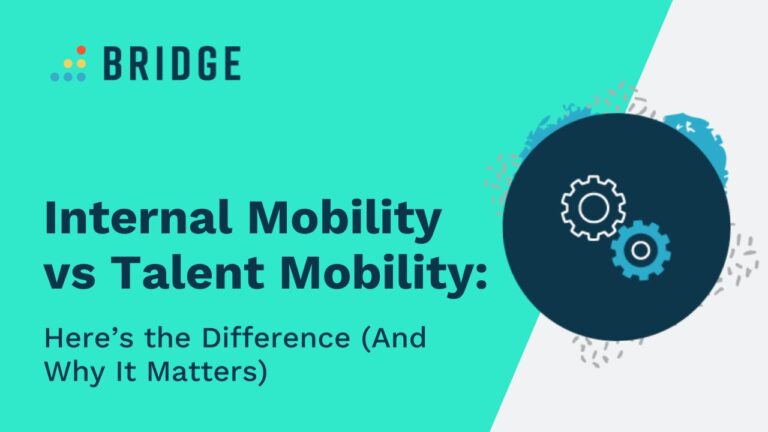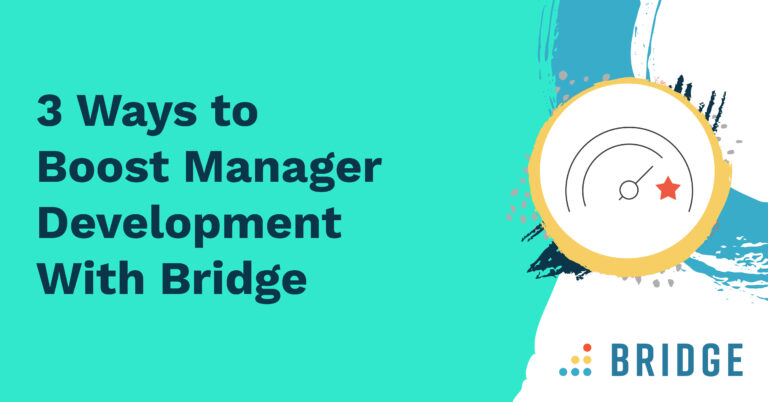As you navigate the world of skill development and talent management, you’ll likely come across two important (and interrelated) practices: internal mobility and talent mobility. To the non-specialist, these terms can look interchangeable, but they’re not the same thing—and you’ll benefit from a clear understanding of the part each one plays in your employee mobilization process.
That’s why we’ve put together this handy cheat sheet to help you gain a little clarity on these easily conflated ideas. Read on and discover what talent mobility means, and how internal mobility fits into your talent mobility plans.
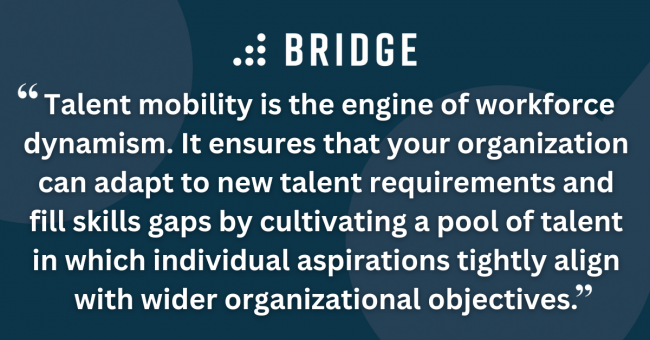
What Is Talent Mobility?
Talent mobility is all about the strategy behind employee movement, encompassing internal and external candidates. It’s about optimizing your existing talent to ensure that the right people are placed in the right roles while simultaneously upskilling and developing employees to help them become the right people for future roles.
In order to achieve this, talent mobility strategies involve understanding the skills, experiences, and career interests of your employees. This process allows you to recognize when an employee would be a good fit for an internal vacancy, and where others might need to develop in order to maximize the value they create in their current positions. Some talent mobility schemes might involve mentorship and training recommendations that help your people to develop in just the right direction.
In short: talent mobility is the engine of workforce dynamism. It ensures that your organization can adapt to new talent requirements and fill skills gaps by cultivating a pool of talent in which individual aspirations tightly align with wider organizational objectives.
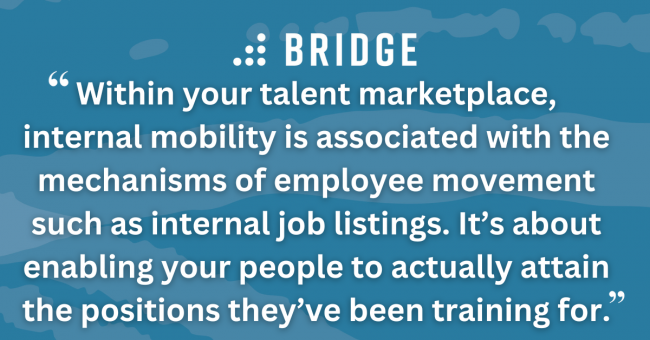
So, Where Does Internal Mobility Fit In?
Internal mobility specifically refers to the practical aspects of moving your people from one position to another. As such, it forms part of your broader talent mobility strategy (albeit a pretty big part!).
Promotions, lateral moves, and temporary assignments to short-term projects all fall under the purview of internal mobility. Within your talent marketplace, internal mobility is associated with the mechanisms of employee movement such as internal job listings. It’s about enabling your people to actually attain the positions they’ve been training for.
Here’s How Talent Mobility and Internal Mobility Work Together
There’s an easy way to differentiate between talent mobility and internal mobility: just try to picture one without the other.
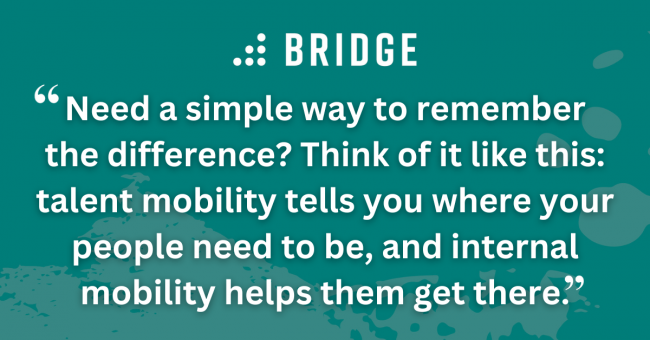
Scenario 1: Talent Mobility Without Movement Mechanisms
Imagine that you’ve put together a talent mobility strategy, but you haven’t put any thought into the specifics of internal mobility—perhaps because your L&D or HR team hasn’t introduced the concept or laid out the distinction. In that scenario, you’ll likely have an ironclad sense of your organization’s talent needs and a solid picture of your current skills gaps. In other words: you’ll know where your people need to move.
However, without internal mobility mechanisms in place, you won’t be able to effectively turn insight into action. It’s no good understanding where your people need to be if you can’t actually get them there! Your grand designs need to be supported by things like formal job posting systems and opportunities for gig work, or else your workers’ professional development goals are unlikely to come to fruition.
Crucially, your organization’s ability to leverage both talent mobility and internal mobility can have practical consequences. If you’re unable to effectively move and redeploy your people in line with your strategy and their aspirations, they might just leave. In 2022, Gartner found that employees were quitting for better professional development opportunities at around the same rate as those leaving for increased pay.
DISCOVER MORE TALENT MOBILITY ADVANTAGES | ‘4 Cross-Stakeholder Benefits of a Talent Marketplace’
Scenario 2: Internal Mobility With No Talent Mobility Strategy Behind It
There’s a similar story to be told if you reverse the premise. Your internal mobility program might allow your people to move effortlessly from one position to the next, but without the oversight and strategic force of a talent mobility plan, your people’s movements will be sub-optimal at best—and aimless at worst.
For example, if a new role opens up and you’re not sure of the skill requirements for that role, you might end up seamlessly transitioning an employee into a position they’re not suited for. Alternatively, you might have exactly the right person waiting in the wings, only to overlook their potential because you haven’t got visibility of their current competencies. In either case, you’re left with a skills gap that hasn’t been properly filled.
Given that 69% of managers in 2023 agree that their organization has a skills gap, it’s never been more essential to ensure that you can plan for, recognize, and fill your skills gaps. By extension, that means backing up your internal mobility practices with a strong talent mobility framework—and understanding the distinctions between the two.
A Final Word on Internal Mobility and Talent Mobility
Clearly, it’s worth ensuring that your talent mobility program includes strong internal mobility mechanisms—and that your internal mobility practices are underpinned by a larger strategy.
Need a simple way to remember the difference? Think of it like this: talent mobility tells you where your people need to be, and internal mobility helps them get there.
RELATED READING | ‘How to Build a Job Architecture With AI-Assisted Skills Matching’
Ready to Put Your Talent Mobility Knowledge Into Practice?
Bridge’s upskilling platform, Skills Plus, is the perfect way to gain a high-level overview of your organization’s required skills with its skill taxonomies feature—while its learning and mentor recommendations will allow you to keep your internal mobility process running smoothly. Request a demo to experience the platform for yourself.
